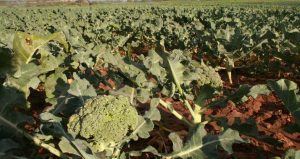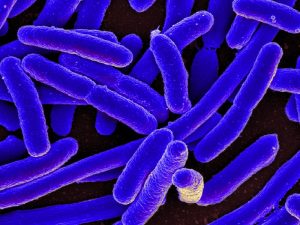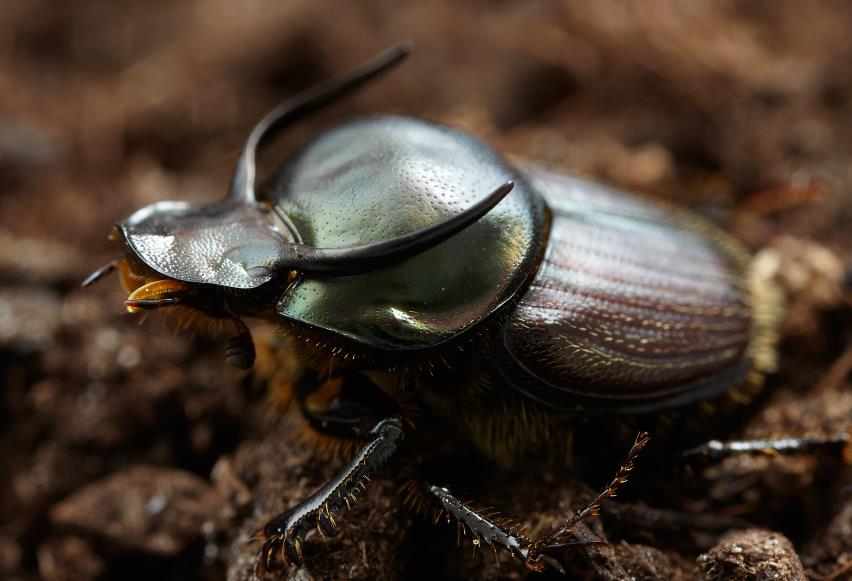A team of researchers from Washington and California have just published a paper revealing some interesting unintended consequences of conventional framing practices, with possibly important implications for food safety.
Escherichia coli is a human-pathogenic bacteria that is commonly found in livestock and wildlife manure. It can end up on produce when manure is used for fertilizer, or introduced from nearby wildlife habitat or pastures. Certain strains of E. coli bacteria can cause serious food poisoning episodes involving produce, especially E. coli O157.
But, microorganisms and insects that live on and in soil also help break down feces that end up in vegetable fields. These caoprophagus, or feces-feeding, insects can significantly reduce the amount of E. coli that ends up on vegetable crops. One species of dung beetle in particular, Onthophagus taurus (see photo top right), is particularly effective.
But, on the flip side, caprophagus flies like the aptly-named Calliphora vomitor can help spread E. coli onto nearby vegetables as they fly from their dinner of feces to land on nearby plants.
This research team set out to determine whether the pesticide-free environment on organic farms resulted in a more robust population of caprophagus flies and beetles, as well as how the numbers of O. taurus and C. vomitor at a given farm would impact E. coli contamination on the produce grown there. Their clever experiment uses both field and laboratory data to help understand the relationship between insect populations and risks from E. coli.

In the field component, the research team surveyed insect populations on 49 mixed-vegetable farms in Oregon and California over a two year period. Eleven of these were conventional farms, while the other 38 farmed vegetables organically (either certified organic or using organic practices).
About half these organic farms were “integrated” operations that also had livestock or poultry on site. This practice is relatively common on organic farms and may potentially lead to a greater food safety concerns, given the close proximity of crops and a manure source of E. coli. And, all farms grew broccoli, a vegetable whose low-growing profile, coupled with the fact that it is often eaten raw, can increase the risk of contamination leading to illness in humans (Jones et al., 2019).
Over the two year sample period they collected around 30,000 flies and dung beetles. Around 7% of the flies were from the Calliphoridae family, while close to 23% of the dung beetles were the focus species. They reported that “the known pathogen-vectors of interest (Calliphorid flies) were embedded within all farm management types, while our most effective known pathogen suppressor (O. taurus) was associated most strongly with organic and integrated farms.” In other words, the “bad” bugs were everywhere, but the “good” bugs were mostly just on organic farms.
The research team then designed a lab experiment to test how the population of coprophagus dung beetles and flies were impacting both the amount of E. coli in manure, and the movement of that bacteria onto nearby crops. So, they created microcosm farm habitats with soil, water, and one leaf from a broccoli plant. A sample of fresh pig feces that had been inoculated with E. coli 0157:H7 was placed in each one.
After separating out some controls, they added insects to the microcosms. Some received only flies, some just dung beetles, and some both. The insects were allowed to feed on the feces for 13 days, and then they measured the pathogen load on the flies, soils, and leaves.

They found that the presence of dung beetles significantly lowered E. coli levels across the board – in fact, “bacterial densities were reduced ca. 92% in the presence versus absence of these dung beetles.”
The presence of dung beetles also “marginally” reduced the survivorship of flies in the habitat, and flies that shared habitat with dung beetles had significantly lower pathogen levels. But, in those microcosms that had flies, pathogen levels were significantly higher on the broccoli leaves.
The team’s major finding is that: “This suggests that, while a fly species likely to vector E. coli occurs in all systems, the dung beetle species most likely to reduce the pathogen occurs most often in the two organic systems.”
This study paints a vivid picture of the complex interactions between crops, insects, soil, and microorganisms that affect every farm ecosystem. It also tracks how such interactions can impact human health. The pesticides that are so common on conventional farms don’t just kill target insects, they also disrupt the farm ecosystem in ways we are just beginning to understand.
This study suggests that organic agriculture can lower the risk of food poisoning from E. coli on fresh vegetables. This research can now “join a long list of ecosystem services thought to be improved on organic farms, including biological control, pollination, and enhanced soil health.”
Source:
Jones, Matthew S., Wright, Stephanie A., Smith, Olivia M., Besser, Thomas E., Headrick, David H., Reganold, John P., Crowder, David W., & Snyder, William E.; “Organic farms conserve a dung beetle species capable of disrupting fly vectors of foodborne pathogens;” Biological Control, 2019, 137; DOI: 10.1016/j.biocontrol.2019.104020.

